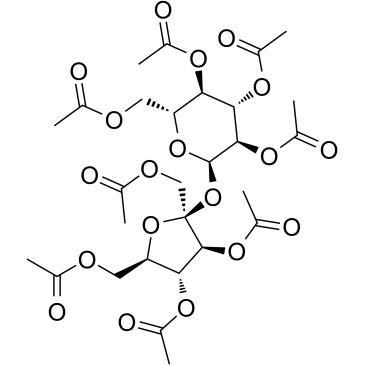Sucrose octaacetate |
| Catalog No.GC38851 |
L'octaacétate de saccharose est un dérivé acétylé du saccharose au goÛt intensément amer et peut être utilisé comme substitut au goÛt amer.
Products are for research use only. Not for human use. We do not sell to patients.

Cas No.: 126-14-7
Sample solution is provided at 25 µL, 10mM.
Sucrose octaacetate is an acetylated derivative of sucrose with an intensely bitter tasting and can be used as bitter tasting surrogate. Sucrose octaacetate can be used as food additive and also used as an adhesive and plasticizer. Sucrose octaacetate also used in many pesticides, insecticides, and other toxic products as a deterrent to accidental poisoning. Sucrose octaacetate can also be used as an in situ seed and a soft template to synthesize polyaniline (PANI) nanofibers[1][2][3].
Sucrose octaacetate is nontoxic and has a number of uses based on its bitter taste. For example, sugar is rendered too bitter is eat at a concentration of 0.06% (w/w) Sucrose octaacetate. Sucrose octaacetate can form 255 different possible isomers and degradation products, all of which have a very low molar absorptivity[1]. Polyaniline (PANI) nanofibers and nanorods are obtained using 2 and 3 g Sucrose octaacetate, respectively. The nanostructures containing irregular-shaped agglomerates, such as particulate particles and scaffolds are observed with increasing the concentrations of Sucrose octaacetate. The presence of Sucrose octaacetate during polymerization could only induce a change in morphology, but could not influence the molecular structure of the resulting PANI. Compared with those derived with 1, 3, and 4 g Sucrose octaacetate, the polymerized PANI from 2 g Sucrose octaacetate possesses higher thermal stability and electrical conductivity due to its higher crystallinity and highly ordered structure[3].
No recombination has been found between Sucrose octaacetate-avoidance phenotype and PRP haplotype in any mouse population. Soa and Prp, therefore, are either very near each other or identical. To assess the latter possibility, two type-A, proline-rich protein genes (MP2 and M14), situated approximately 30 kb apart at the Prp locus, are separately transferred from a Sucrose octaacetate-taster inbred strain (SWR) to a Sucrose octaacetate-nontaster inbred strain (FVB). Five MP2-transgenic mice and seven M14-transgenic mice are insensitive to 1 mM Sucrose octaacetate in two-bottle tests, thus retaining the nontaster FVB phenotype. Expression of mRNAs for both type-A Prp genes alone or together do not enhance SOA taste sensitivity in nontaster mice[2].
[1]. William CraigStagner, et al. Chapter Five - Sucrose octaacetate. Profiles of Drug Substances, Excipients and Related Methodology. Volume 44, 2019, Pages 267-291. [2]. Harder DB, et al. Sucrose octaacetate avoidance in nontaster mice is not enhanced by two type-A Prp transgenes from taster mice. Chem Senses. 2000 Feb;25(1):39-45. [3]. HuaQiu, et al. Synthesis of polyaniline nanostructures via soft template of sucrose octaacetate. Synthetic Metals.Volume 160, Issues 11-12, June 2010, Pages 1179-1183.
Average Rating: 5 (Based on Reviews and 34 reference(s) in Google Scholar.)
GLPBIO products are for RESEARCH USE ONLY. Please make sure your review or question is research based.
Required fields are marked with *




















